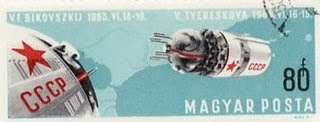Valentina Tereshkova was launched into space aboard the Soviet Vostok 6 spacecraft and returned to earth after almost 3 days having completed 48 orbits of the planet. To put this into the context of the space race at the time, with this flight Tereshkova logged more space flight time and earth orbits than all the American Mercury astronauts combined and at 26, she was also ten years younger than the youngest Mercury Seven astronaut, Gordon Cooper. Her call sign during the flight was Chaika, which means seagull and this was later commemorated as the name of an asteroid, “1671 Chaika”. Vostok means East or Orient.
While all the American Mercury astronauts were military test pilots, Tereshkova worked in a textile factory and before that a tire factory. However, she wasn’t just picked at random to prove the superiority of all Soviets over their capitalist counterparts. Tereshkova was a keen parachutist before volunteering for the cosmonaut programme, making her first jump in 1959 aged 22. Being a parachutist was just one of the criteria for being selected for being a cosmonaut (as at this time cosmonauts jumped from their spacecraft before they hit the earth, not recommended without a parachute) and Tereshkova was one of five finalists selected from more than four hundred original applicants. Tereshkova was the only one of the five to get an opportunity to fly in space, however, all five undertook a lot of rigorous training before they were considered for spaceflight.
Once in orbit Tereshkova performed a number of tests on herself, collecting data on the female body's reaction to spaceflight. She experienced nausea and physical discomfort for much of the time but wasn’t alone in this, a number of cosmonauts and astronauts suffered with this problem, she was probably just more open about it. Tereshkova maintained a flight log and took photographs of the earth’s horizon, which were later used to identify aerosol layers within the atmosphere.
The Vostok 6 was launched just two days after Valery Bykovsky’s Vostok 5 spacecraft. Although the two spacecraft came as close as 5km and were able to communicate by radio, they did not rendezvous in space. A space rendezvous is a tricky manoeuvre and wasn’t accomplished until 1965 by the American’s with Gemini 6A and Gemini 7. This isn’t to take anything away from the Soviet achievement; the American’s were still way behind in the space race at this point. Bykovsky in the Vostok 5 maintained his orbit for 5 days, to this day the endurance record for a solo spaceflight. He landed three hours after Tereshkova’s return to earth. The Vostok 6 was the final Vostok flight being replaced by Voskhod (meaning ascent or dawn), although this was actually a modified Vostok.
Valentina Tereshkova became of Hero of the Soviet Union and an inspiration to women everywhere. Not bad for someone who first went to school aged 8 or 10, leaving at 16 to work in a factory like her mother. Tereshkova’s father, Vladimir Tereshkov, was a tractor driver who became a war hero when, as a tank leader sergeant, he was killed in the Finnish Winter War during World War II. When she was asked what reward she would like for making her historic spaceflight, Tereshkova asked that her father’s remains in Finland be found, which they were and they also placed a memorial to him there.
Although Tereshkova’s time in school had been short, she continued her education by correspondence course. After her spaceflight she studied at the Zhukovsky Air Force Academy, graduating with distinction as a cosmonaut engineer and earning a doctorate in engineering in 1977. She was also a prominent member of the Communist Party and held a number of important political positions. In 1997, in post Soviet Russia, she was retired from the Air Force and the Cosmonaut Corps by presidential order. While at President Vladimir Putin's residence in Novo-Ogaryovo for the celebration of her 70th birthday, Tereshkova said she would like to fly to Mars, even if it was a one way trip.
Valentina Tereshkova was married twice, the first time in November 1963 to another cosmonaut, Andrian Nikolayev, with Khrushchev himself presiding at the wedding party. Tereshkova and Nikolayev had a daughter Elena Nikolaeva-Tereshkova, who was born in 1964, and was the first person to have parents who had both travelled into space. Elena is now a doctor. Tereshkova and Nikolayev divorced in 1982. Her second husband, Yuli Shaposhnikov, died in 1999.
Tereshkova has done much to promote feminist issues and women’s rights as well as being a space heroine. You can find out more about her by reading the book “Into That Silent Sea” by Colin Burgess and Francis French. I haven’t read this book myself yet, but I’m told it examines the lives of a number of the very first cosmonauts and astronauts including Tereshkova’s life and spaceflight in some detail along with interviews with Tereshkova herself. 








No comments:
Post a Comment